Subtotal: $
Checkout-

War and the Church in Ukraine
-

The Griefs of Childhood
-

Everything Will Not Be OK
-

Jesus and the Future of the Earth
-

The Other Side of Revelation
-

American Apocalypse
-

Syria’s Seed Planters
-

At the End of the Ages Is a Song
-

Searching for Safety
-

Stable Condition
-

Editors’ Picks: “In the Margins”
-

Editors’ Picks: “The Genesis of Gender”
-

Editors’ Picks: “Sea of Tranquility”
-

Poem: “Stopping By with Flowers”
-

Poem: “Sugarcane Memories”
-

Poem: “Sonnet Addressed to George Oppen, Arlington National Cemetery”
-

Diaconía Paraguay
-

Winners of the Second Annual Rhina Espaillat Poetry Award
-

Forum: Letters from Readers
-

Charles de Foucauld
-

Covering the Cover: Hope in Apocalypse
-

War Is Worse Than Almost Anything
-

The Last Battle, Revisited
-

The Problem with Nuclear Deterrence
-

A Haven of Olives
-

Book Tour: Time for an Intervention
-

Hoping for Doomsday
-

Radical Hope
-

The Sermon of the Wolf
-

The New Malthusians
-

The Spiritual Roots of Climate Crisis
-

Tradition and Disruption

The Apocalyptic Visions of Wassily Kandinsky
As the world careened toward the Great War, a Russian artist pioneered a path out of the material to the spiritual.
By Shira Telushkin
June 2, 2022
There is a moment, as one rounds the final span of the four-level exhibit of Wassily Kandinsky’s works at the Guggenheim in New York, on display through September 2022, where the art gives way to an almost transgressive sense of intimacy.
The exhibit, Around the Circle, is hung in reverse chronological order: We begin at the end, with the artist’s final years in 1940s Paris. The show then winds upward through two world wars, the Russian Revolution, his drawings, sketches, the writings on theory and art. As we move back through time, the works start to come into focus, the abstract lines and circles turning back into legible shapes and forms. A house suddenly comes into view as one finally reaches the beginning of the 1910s, his earliest period. A few paces later there are men and women unambiguously conversing over a picnic. Perpendicular to this painting is a train, pumping a recognizable pillar of steam through clearly discernible mountains. We have wound back to Kandinsky’s first forays into painting, the start of his experiments with color and texture and light. After nearly seventy works of nuanced spiritual abstraction, these early works hold an almost childlike wonder, so straightforward and requiring no translation. They are still impressionistic, almost dreamlike in their blurred silhouettes and textured brushstrokes of primary colors, but they feel personal, stripped of those outer layers of meaning and symbolism we have come to expect. It is as if we’ve intruded on the artist at home, unvarnished, playing around with friends and family, not suited up for serious theological debate.
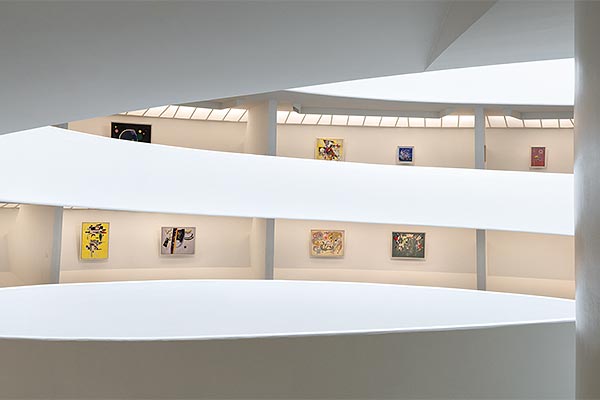
View of the exhibit Vasily Kandinsky: Around the Circle, Solomon R. Guggenheim Museum, New York Installation view, Vasily Kandinsky: Around the Circle, Oct. 8, 2021–Sept. 5, 2022, Solomon R. Guggenheim Museum, New York. Photograph by David Heald © Solomon R. Guggenheim Foundation, New York.
Having reached the end of the exhibit and the beginning of his life up at the top, I now retrace my steps to the bottom. On this pass, the later paintings seem suddenly sharper, more insightful. The titular painting of the exhibit, Around the Circle (1940), stops me in my tracks. These works are viewed, on the return, through the prism of those early works, the directions Kandinsky did not take. I’m not sure the payoff would be the same if the show had started in this earliest era, the paintings growing increasingly bold and abstract to better capture the bold and abstract ideas Kandinsky held about art as a spiritual tool. But by moving backward then forward through time, I can be newly caught by his end, by the strange trajectory his relationship to art and apocalypse and time itself seems to have taken.
Around the Circle is a complex work oriented around a red circle with a purple halo and yellow dot hovering over various other forms set against a dark green canvas. In the bottom right-hand corner there is the outline of an upside-down man, composited from a variety of colors, shapes, and patterns. To his left is a door perched above a short flight of stairs, under a collection of bulbous buildings, springing from the crest of a mountain. The sunlike red circle, the man in freefall, the stairs leading up to the door leading up to the city leading back to the sun. The cycle of life. It is an image so quintessentially Kandinsky – the artist’s embrace of circles as symbolic of a world which, in his last years, he saw as cyclical, rising and following and moving in never-ending patterns of time and space – that it barely registered when I had first walked in.
Now it captures me.
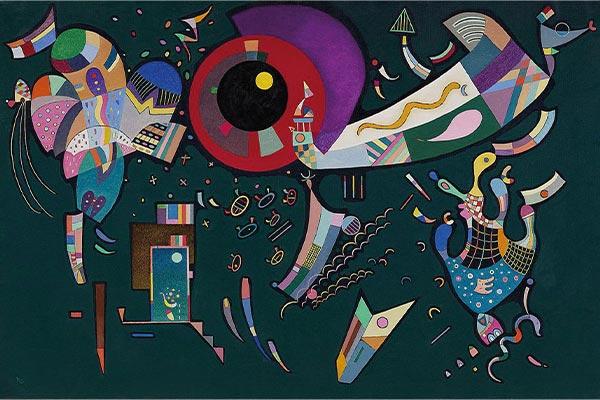
Wassily Kandinsky, Around the Circle, May–August 1940 All artwork images public domain
It sits next to Dominant Curve (1936), completed three years after the Russian-born Kandinsky arrived in Paris. With its intersecting circles of orange, yellow, teal, and pale blue, the painting is unmistakably joyful and full of hope.
Who was full of hope in Europe in 1936?
Three years earlier, Kandinsky had fled to Paris from Germany, after the Nazi party shut down the Bauhaus, the influential art school he had helped found in Munich, and threatened to imprison artists, writers, and academics associated with it. And yet in this final stage of his life’s work, I see all around me on the gallery floor an energy of gentleness, a move away from his severe geometrical triangles and precise lines to pastel colors and free-floating orbs. Somehow, political turmoil made Kandinsky softer, not harder. Somehow, it was in this period that he became convinced, more than ever, that the world is always evolving and never ending, not marching along a predetermined timeline to some final conclusion.
What an unexpected landing point for an artist who began his spiritual and artistic quest in the 1910s, built on visions of apocalyptic destruction and chaos.
Wassily Kandinsky (1866–1944) was born in Moscow but grew up in Odessa, where he attended art school. He returned to Moscow to pursue law and economics, but a radical encounter with a painting set him on a new course. In 1893, he came across Claude Monet’s Haystacks at Giverny (1891) in a gallery. He was dismayed: he found himself unable to discern what the painting was meant to represent. He would later write, “This lack of clarity was unpleasant to me: I thought that the painter had no right to paint so unclearly.” But the encounter with Monet opened up an important revelation: Art did not have to be simply a reproduction of the world we live in.
For the first time, Kandinsky began to wonder if paintings could not just mimic the physical world, but draw viewers into a higher spiritual consciousness, away from the physical world. Perhaps art could counteract the materialism he saw consuming society, by serving as a portal to divine experiences.
Three years later, in 1896, the thirty-year-old Kandinsky would turn down a prestigious professorship at the University of Dorpat and move to Munich to find his way as an artist.
The path was not easy.
Kandinsky arrived in Munich with nothing but drawings from his school days, and was turned down by nearly every studio and teacher in town. Eventually, with continued practice and persistence, he got himself accepted to a respected studio. Even then, he struggled. He found it maddening to watch artists squander their talent on pretty flowers and nude models, instead of investigating the spiritual potential of their work. In a letter to a friend, he recalled how students would sit for hours in stuffy rooms before an “apathetic, expressionless” model, “trying to represent exactly the anatomy, structure, and character of these people who were of no concern to them,” obsessed with the techniques of cross-hatching muscles or shading a nostril or lip, while “they spent, it seemed to me, not one second thinking about art.”
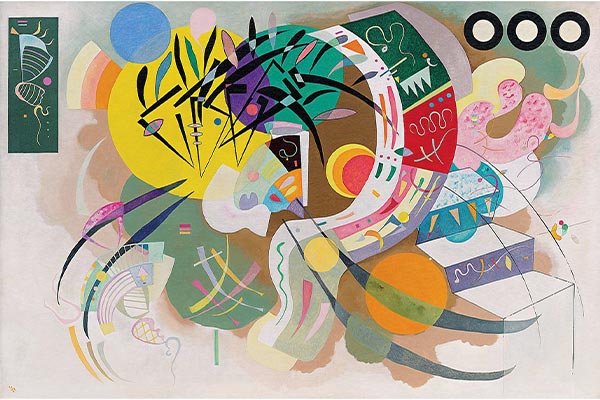
Wassily Kandinsky, Dominant Curve, April 1936
Over the years, he would find pockets of inspiration. On a 1908 trip to Bavaria, he became entranced by the local folk art made in glass, depicting saints and Christian heroes with few details but tremendous power. The trip reminded him of an ethnographic study he had conducted in 1889 on the origins of Siberian culture and decoration. The simple, soulful style of the Siberian homes he visited – completely wrapped in bold, decorative art – had struck him as more communicative, more all-consuming, than most of the art one encountered on the walls of European museums. Once again, Kandinsky found that the lack of realism in the folk art of Bavaria allowed the viewer to be transported, as it were, to a realm of the spirit.
In these early years, Kandinsky was most interested in figuring out how to unlock the spiritual possibilities of visual art. A lifelong synesthetic – colors held sounds for him, and he saw colors when he heard words – Kandinsky moved between art forms naturally. He wrote plays and scored librettos. He was exquisitely sensitive to the ways colors interacted and evoked different moods and feelings. He began to seek out writers, thinkers, and other artists who shared his sense of cosmic urgency. Along with friends, he founded a series of societies and magazines. By the start of the 1910s, a burgeoning community of similarly minded people had taken root.
Slowly, he developed a theory of how abstract art could meet its spiritual promise. While to Kandinsky art that merely reproduced the world was worth less than nothing, still for an artist “to limit himself to the purely indefinite would be to exclude the human element and weaken his power of expression.” In other words, images should not be so realistic that they draw a soul down to the material world, but they needed to be recognizable enough to say something. For this reason, he was intrigued by imagery that could provide shorthand for complex ideas, allowing works to stay abstract but not forgo all communication. His vividly colorful Composition VI (1913), for example, swirls a variety of shades across the canvas with only the suggestion of a hand blowing a trumpet in the left-hand corner, a single clue by which the viewer can access the redemptive message of the painting.
“Our epoch is a time of tragic collision between matter and spirit and of the downfall of the purely material world.” —Wassily Kandinsky
The project felt all the more urgent because Kandinsky believed a crisis was imminent, and artists could either help or do more harm. “Our epoch is a time of tragic collision between matter and spirit and of the downfall of the purely material world,” he declared in his 1912 treatise Concerning the Spiritual in Art. In this same essay, he develops the idea of history as a spiritual triangle, where the goal of human endeavor is to both move into the upper portions of the ever-narrowing triangle, and to move the triangle as a whole upward. He isn’t entirely sure why humans need to keep progressing – he acknowledges that “this need to move ever upward and forward” remains “veiled in obscurity” – but he accepts it without question. This is where art becomes so necessary. Kandinsky believed “painting is a power which can be used to serve the improvement and refinement of the human soul – to, in fact, the raising of the spiritual triangle. If art refrains from doing this work, a chasm remains unbridged, for no other power can take the place of art in this activity.”
Given these stakes, Kandinsky bitterly condemned artists who used their gifts to minister to lower needs and “drag back those who are striving to press onward,” writing that people looked to art for spiritual elevation, and should not be disappointed. To paint beautiful women or glittering fruit baskets, which might draw people into galleries to say “how nice” or “how splendid” but turn them back out onto the street neither richer nor poorer, was to allow “hungry souls to go hungry away.” Art could feed these hungry souls, he believed, and to use it for anything baser was a betrayal of the artistic calling.
This anxiety for the fate of the world, and conviction in the power of art to help or hurt, led Kandinsky to see artists as spiritual leaders, says Richard White, a professor of philosophy who has written about Kandinsky’s role in twentieth-century thought. “In Hegel, there are three ways to the absolute: art, religion, and philosophy. Maybe philosophy and religion are not as important as they once were, but art is still so powerful as a way of inspiring people. Some writers talk about how art makes us linger. We look to artists for understanding, and giving us a sense of how the world is. I think Kandinsky saw this as his mission in life.”
In the early 1910s, now deep into his forties but still in the early stages of his artistic pursuits, Kandinsky began exploring images of apocalypse, destruction, and social collapse, drawing mostly from the biblical Book of Revelation. In this he was not alone. Prompted in part by the Russian loss in the 1904 Russo-Japanese war and the first Russian Revolution in 1905, artists and philosophers alike were animated by “a sense of enormous change and apocalyptic feeling,” according to John Bowlt, historian of the twentieth-century Russian avant-garde. Art historian Rose-Carol Washton Long notes similarly that early twentieth-century French and Russian artists, philosophers, and spiritual seekers shared a “messianic vision of a coming utopian epoch.”
Between 1909 and 1914, Kandinsky produced dozens of studies with clearly eschatological titles, including Deluge, All Saints, Resurrection, and The Last Judgement, in addition to the series of numbered Compositions. He experimented with various levels of abstraction and materiality. His 1910 painting, With Sun, for example, is done on the underside of glass, and depicts a city of several towers on top of a hill, with waves of fire and water seemingly threatening on all sides. Three horsemen ride up the left side of the painting, while a man and woman lie motionless in the corner just below them.
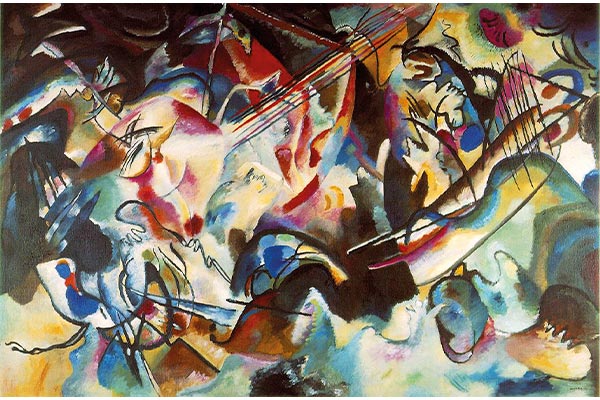
Wassily Kandinsky, Composition VI, 1913
These scenes of destruction were balanced with an equal interest in Revelation’s promise of a new era. In his 1911 All Saints I, a figure sounds a trumpet over a rising sun, while a bevy of Orthodox saints emerge with iconography’s yellow halos around their heads, led by Saint George in his armor. In the distance is a crucified Christ, and to his left is a new city, encircled by a sunlit wall, resting on a hill.
This line of artistic exploration was cut short by a conflict so destructive it might well have seemed apocalyptic. In 1914, as Europe descended into the Great War, Kandinsky was forced to flee back to Moscow, where he lost ties with his community and friends in Munich. He eventually broke off his relationship with the German-born Gabriele Münter and married a Russian woman, Nina Andreevskaya, who would become central to the direction of his career. Separated from his intellectual circles in Germany, Kandinsky found himself in the new world of the Russian avant-garde. Here he discovered a fascination with mathematics and the precise geometric shapes that would mark his later work.
In 1922 he returned to Germany to work with the Bauhaus movement, where he painted a series of noisy, explosive works. Forced again to leave in 1933, Kandinsky ended his years in Paris, never abandoning his urgent spiritual desire to create art that draws the human spirit upward, but never again returning to the themes of apocalypse and cosmic redemption that had gripped him before World War I.
The idea of an apocalypse – that the present world-age might end, by design, in the foreseeable future – is an idea with a definite historical origin. In the final centuries before the Common Era, the notion that history was a sequence of events playing out in ordered time – a sequence that would one day culminate in some sort of final denouement – began to gain traction across various minority communities in the Levant and Mesopotamia ruled by the Seleucid Empire. We know of no recorded developments of this idea outside the empire.
“It’s a reaction formation to the social emergence of a dating system using numbers that never end,” explains Paul Kosmin, a professor of ancient history at Harvard who has written extensively about the apocalyptic imagination in this time.
The Seleucid Empire was the first in recorded history to detach its dating system from major events, kingship cycles, and other finite human activities, giving years numbers that could stretch to eternity instead of fixing them to events that would soon be forgotten.
“This new, Seleucid way of counting time generated a crisis of meaning,” says Kosmin, “and these apocalypses are the most articulated form of restoring meaning to history. They give it shape, structure.”
Up until this point I had only thought of the apocalypse as an ancient idea that felt disturbingly modern because it involved the idea of global destruction. A warming climate, nuclear arms race, and pandemic bring the old themes of war, plague, famine, and death into fresh relief.
Apocalypse is not just about The End. It is also about justice – the promise that in the end good will finally prevail, no matter how awful things seem right now.
Who knew that “crisis of meaning” also deserved to be among this Venn diagram of woes?
“This new sort of linear counting system allowed people to see the kingdom as eternal, or infinite, and it politicized time in a new way,” Kosmin continues, adding that this might be one reason we see apocalyptic narratives emerge only among minority groups living unwillingly under the Seleucid Empire, presumably eager to see it end. “The apocalypse makes it possible to oppose the imperial time system, by bringing time itself, which has become eternally forward-moving, to an end.”
In other words, the apocalypse as protest.
Kandinsky, who saw the world falling faster and faster into an unending materialistic smog of darkness, would have had much reason to be drawn to theories about the end of time, promising new beginnings.
Eleanor Heartney, an art historian and author of Doomsday Dreams: The Apocalyptic Imagination in Contemporary Art (2019), describes a similar impulse today among artists. “The concept of the apocalypse gives history an arc,” she said in a 2020 interview with the Brooklyn Rail, adding that the apocalypse is not just an imagined end, but a critical way to hope for a new beginning.
When people talk about apocalypse, they usually are thinking of spectacular scenarios of death and destruction, with or without a religious twist. But apocalypse is not just about The End, although that is a big part of it. It is also about justice – the promise that in the end (or actually after the end) good will finally prevail, no matter how awful things seem right now. At the moment, that is a particularly appealing idea. The word apocalypse itself means unveiling – it’s about revealing the hidden meanings of history. And we want history to have meaning.
But if Kosmin is right about apocalypse’s specific historical origin, it is not at all obvious that the desire for history to have meaning is inherent to the human condition. Can it possibly be that the desire for ultimate redemption merely emerged in response to a system of calendars introduced by an ancient empire whose name is obscure to most of us?
Perhaps. And yet it seems hard to imagine that the apocalyptic texts originating in this period hold our attention simply because they promise some end. They are also, and always have been, dramatically visual. This was the concept from which the biblical books of Daniel and Revelation, as well as non-canonical texts such as the First Book of Enoch, emerged, rich with bloodied angels, lakes of fire, congealed scrolls of ink, and enough beastly creatures to capture the imagination of an artist of any era or creed.
In these texts, Kosmin sees the cryptic, complex symbols as a way to interpret everyday life in the grandest sense. “These second-century Judean texts don’t say ‘the Seleucid Empire comes out of the sea and is slaughtered,’ but ‘the fourth beast comes out of the sea and is slaughtered,’” he points out. Through symbols, the particular becomes the cosmic; the hope for liberation within time becomes the promise of liberation for all time. “Everything that is happening in the apocalypse to you is happening for you. And you will be the ultimate victor.”
It sounds like a project right up Kandinsky’s abstract alley. Take the world as we know it and portray it through visuals that are both otherworldly and understandable, clear enough to be interpreted by viewers yet undetermined enough to float free of mundane physical events. Is it any wonder these texts retained such theological and visual power over the millennia, and that Kandinsky found in them the tools he needed to tempt the deadened souls of his own generation towards deeper spiritual reflection?
In recent decades, there has been a trend to subsume Kandinsky’s interest in apocalyptic motifs wholly within the broader interests in theosophy and spiritualism present in early twentieth-century Europe. Such influences likely did shape the artist. Theosophists of the time believed folklore and mythology were ideal ways to communicate spiritual concepts to the masses; similarly, the very accessibility of the Revelation motifs might have been one reason Kandinsky turned to the book of Revelation. He was known to express his admiration for Helena Blavatsky, the co-founder of the Theosophical Society in 1875, and even more for Rudolf Steiner, a leader of Christian theosophy who was teaching the Book of Revelation in Munich at the same time Kandinsky lived there. The links to his art seem clear.
But such theories too easily overlook the influence of Kandinsky’s pious Russian Orthodox upbringing and the long tradition of iconography that goes with it.
Kandinsky grew up during the revival of the Russian Orthodox Church’s tradition of iconic images in the late nineteenth century. In Orthodoxy, icons are often seen as guiding objects to help one grow in spiritual awareness, useful to gaze upon during prayer. They are rife with symbolism: the suggestion of a lion, a wheel, or a cloak can instantly conjure up a world of religious themes and emotions for someone educated in the church’s symbolisms. For this tradition, the choice of colors matters immensely, and images are not primarily a narrative or depiction of a scene, but rather a kind of divine ladder to the godly realm.
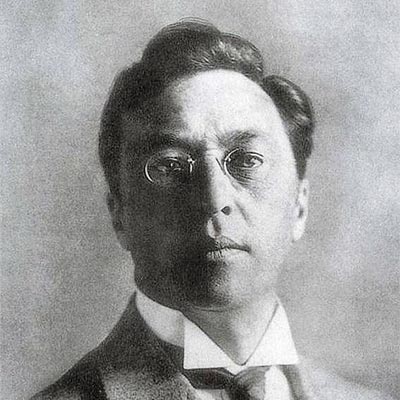
Wassily Kandinsky, ca 1906
It’s a short leap from this way of thinking to Kandinsky’s experiments in abstract art, and one that he was better equipped to make than his Protestant-raised colleagues. As we’ve seen, his attraction to the abstract arose from his desire for art to be a portal to the divine, not a narrative scene, which tends to keep the viewer in this world rather than drawing him or her beyond it. Connecting icons with Kandinsky’s turn to the abstract doesn’t seem so far-fetched, given how strongly Kandinsky expressed his sense of Christian identity in personal writings, even if he rarely articulated confessional beliefs in public.
One riddle remains: Why did Kandinsky lose interest in apocalypse? How did the man drawn in his pre-1914 years to images of the destruction of the world later end up promoting visions of a spiritual cycle of time with no definitive end or beginning?
As I wind through his works in the Guggenheim show, I find myself thinking a clue may lie in the religious motifs on which he so often drew throughout his life. It can be easy to forget that Kandinsky was many things before he was an artist. He was a son, a husband, a lawyer, a child of the Russian Orthodox Church; a seeker and a thinker, a seeing ear and a listening eye. Writing in 1913 to a friend, Kandinsky mused about the similar avenues of rupture and rebirth that religion and art offer:
Art in many respects resembles religion. Its development consists not of new discoveries that obliterate old truths and stamp them as false (as is apparently the case in science). Its development consists in moments of sudden illumination, resembling a flash of lightning, of explosions that burst in the sky like fireworks, scattering a whole “bouquet” of different colored stars around them. This illumination reveals with blinding clarity new perspectives … the continuing growth of earlier wisdom, which is not canceled out by the latter, but remains living and productive as truth and as wisdom. Christ, in his own words, came not to overthrow the old law, [but] he transformed the old material law into his own spiritual law. In this way, I have since come to conceive of nonobjective painting not as a negation of all previous art. I have always been put out by assertions that I intended to overthrow the old tradition of such painting.
The end was never an end, for Kandinsky, but always a transformation. Not an overthrow of the world but a sublimation into something new. Even after he moved on from his preoccupation with the Book of Revelation, he retained his determination to keep moving upward, even if by the end of his life he wasn’t sure there would ever be a final resting stop.
For all his frustration with other artists, Kandinsky never wavered in his belief in the power of art to be a spiritual catalyst. In his words: “Despite all this confusion, this chaos, this wild hunt for notoriety, the spiritual triangle slowly but surely with irresistible strength moves onward and upward. The invisible Moses descends from the mountains and sees the dance round the golden calf. But he brings with him fresh stones of wisdom to man.”
Already a subscriber? Sign in
Try 3 months of unlimited access. Start your FREE TRIAL today. Cancel anytime.











































David McManus
A very thoughtful appreciation of his work and lifestyle.